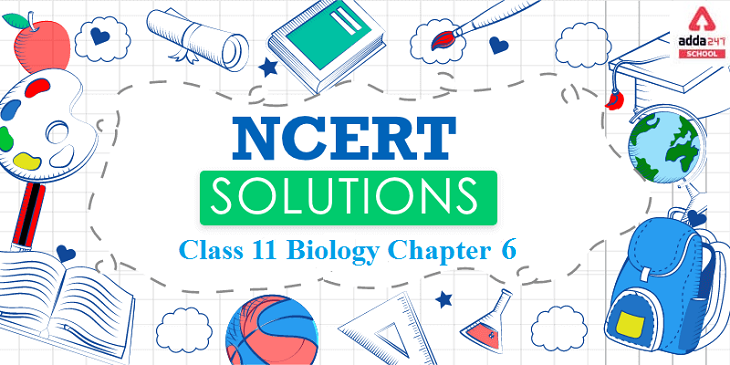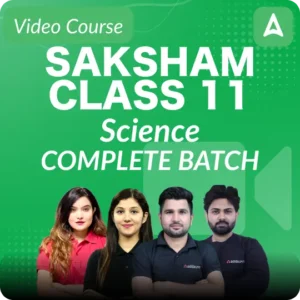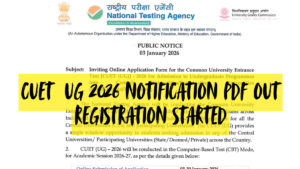Ncert Solutions for Class 11 Biology Chapter 6 in English
Adda 247 provides NCERT Solutions for Class 11 Biology Chapter 6 which is for the students who want to go ahead in life and achieve great marks in their examinations. The NCERT Solutions for Class 11 Biology Chapter 6 are provided by the teachers who are experts of their subjects. The solutions are set according to the rules formulated by the NCERT and in the language that can be understood by every student. By these reading the solutions students can build up a strong base easily. The NCERT class 11 Biology solutions covers the chapters 1 to 22 with the important questions and the answers in a detailed way.
Examinations can be threatening for some people, a proper learning of the concepts is the key to crack the examination. Students rely on the solutions of the NCERT provided by Adda 247. The solutions are formulated by the experts of the subjects who have tremendous knowledge in their subjects.
These NCERT Solutions help the students to get familiarized with the textbooks. The students can access the solutions anywhere while browsing the web easily. The solutions are very precise and accurate.
NCERT Solutions for Class 11 Biology Chapter 6 – Anatomy of flowering plants
NCERT Solutions for Class 11 Biology Chapter 6 provides information about Anatomy of flowering plants. NCERT Solutions for Class 11 Biology Chapter 6 tells that plants are made of different varieties of tissues. Also, these tissues are broadly categorized as meristematic and permanent tissue. Furthermore, these tissues assimilate foods and store it, transport water, mineral and perform various other activities. Moreover, photosynthesis and mechanical support are their functions. Generally, there are three types of tissue system namely epidermal, ground, and vascular. Also, these tissue forms different parts of plants. In addition, the ground tissue system forms the main bulk of the plant. Most noteworthy, they are divided into 3 zones- cortex, pericycle, and pith.
The xylem and phloem form the vascular system. Also, the vascular system is of different types. Furthermore, monocotyledons and dicotyledonous plants marked variation in their internal structures. In addition, they differ in type, location and number in vascular bundles.
[sso_enhancement_lead_form_manual title=”Download Full PDF of Class 11 Biology Chapter 6 ” button =”Download Now” pdf =”/jobs/wp-content/uploads/2021/06/12070117/English-chapter-6.pdf”]
Key Features of the NCERT Solutions for Class 11 Biology Chapter 6- Anatomy of flowering plants
NCERT Solutions for Class 11 Biology Chapter 6 have been answered based on the important information on the question.
- The columns are used wherever necessary.
- Solutions are solved point-wise and accurately answered point to point.
NCERT Solutions for Class 11 Biology Chapter 6: Important Questions
Question 1. State the location and function of different types of meristems. Answer: On the basis of location, meristems are of three types, apical, intercalary and lateral.
(i) Apical: It is present at the apices of stem, root and their branches. It helps in growth in length and formation of primary tissues.
(ii) Intercalary: It is found above or below stem nodes and leaf bases. It helps in growth of internodes, growth in leaves and correction of position in lodged stems.
(iii) Lateral:
(a) Phellogen (Cork cambium): It arises from the hypodermis in stems and pericycle in the roots. It helps in the formation of protective cork and aerating lenticles on the outside and secondary cortex on the inner side.
(b) Vascular cambium: In stem it is formed from intra-fascicular cambial strips and interfascicular strips. In root it develops from conjunctive parenchyma and pericycle. It helps in formation of secondary phloem on the outer side and secondary xylem on the inner side. The vascular rays are formed at the intervals for radial conduction.
Question 2. Cork cambium forms tissues that form the cork. Do you agree with this statement? Explain.
Answer: Phellogen or cork cambium is a couple of layers thick. The layers are made up of narrow, thin- walled and nearly rectangular cells. Cork cambium cuts off cells on both sides of these the outer cells differentiate into cork or phellem while the inner cells differentiate into secondary cortex or phelloderm. The phellem and phelloderm formed from the cork cambium or phellogen are collectively known as the periderm.
Question 3. Explain the process of secondary growth in the stems of woody angiosperms with the help of schematic diagrams. What is its significance?
Answer: In woody dicots, the strip of the cambium located between the primary xylem and phloem is known as the interfascicular cambium. The cambium is formed from the cells of the medullary rays adjoining the interfascicular cambium. This results in the formation of a continuous cambium ring. The cambium cuts off new cells toward its either sides. The cells located towards the outside differentiate into the secondary phloem, while the cells cut off toward the pith gives rise to the secondary xylem produced is more than that of the secondary phloem. The secondary growth increases the girth of plants increases the amount of water and nutrients to support the growing number of leaves and also provides support to plants.
Question 5. Cut a transverse section of young stem of a plant from your school garden and observe it under the microscope. How would you ascertain whether it is a monocot stem or a dicot stem? Give reasons.
Answer:
| Monocot stem | Dicot stem |
| The scattered vascular bundle can be seen without specific pattern on the cytoplasm. | The vascular bundle can be seen with a pattern of a ring formation in the cell. |
| Parenchyma are present in the cortex region. | Parenchyma can be seen with half present in the pith region and half surrounded by the vascular bundle. |
| No pith can be seen in the slide. | Pith can be seen. |
| The epidermis region is large, acquiring more regions compared to the vascular region. | Epidermis covers a small area as compared to monocot. |
Question 6. The transverse section of a plant material shows the following anatomical features – (a) the vascular bundles are conjoint, scattered and surrounded by a sclerenchymatous bundle sheaths. (b) phloem parenchyma is absent. What will you identify it as?
Answer: The monocot stem has conjoint, collateral and closed vascular bundles which are scattered in the ground tissue containing the parenchyma. Each vascular bundle is surrounded by sclerenchymatous bundle-sheath cells. Phloem parenchyma and medullar rays are absent in monocot stems.
Question 7. Why are xylem and phloem called complex tissues?
Answer: The Xylem and phloem are composed of more than one type of cells which work as a unit.
Xylem helps in conducting water and minerals. It is made up of the following components: A. Tracheids (xylem vessels and tracheids)
B. Xylem parenchyma
C. Xylem fibres
These cells work together in coordination and help in the storage of food materials and in the radial conduction of water. Phloem helps in conduction of food materials, composed of:
- Sieve tube elements B. Companion cells
C. Phloem parenchyma D. Phloem fibres
The cells of the phloem work as a unit to conduct prepared food from the leaves to the different part of the plants.
Question 8. What is stomatal apparatus? Explain the structure of stomata with a labelled diagram.
Answer: Stomata are the small pores present in the epidermis of leaves. They regulate the process of transpiration and gaseous exchange. The stomatal pore is enclosed between two bean shaped guard cells. The inner walls of guard cells are thick, while the outer walls are thin. The guard cells are surrounded by subsidiary cells. These are the specialised epidermal cells present around the guard cells. The pores, the guard cells, and the subsidiary cells together constitute the stomatal apparatus.
Question 9. Name the three basic tissue systems in the flowering plants. Give the tissue names under each system.
Answer: The three basic tissue system in plants are:
(i) Epidermal tissue system: It forms the outermost covering of the whole plants body. It comprises of epidermal cells, stomata and the epidermal appendages like trichomes and hairs.
(ii) Vascular tissue system: It consists of phloem and the xylem.
(iii) Ground tissue system: All the tissues except the vascular bundles and the epidermis constitute the ground tissue system. These include parenchyma, collenchyma and sclerenchyma and mesophyll cells.
Question 10. How is the study of plant anatomy useful to us?
Answer: The study of plant anatomy helps to understand the structural adaptations of plants with respect to diverse environmental conditions. It helps us to distinguish between monocots, dicots, and gymnosperms. Such as study is linked to plant physiology. Hence, it helps in enhancement of food crops. The study of plant-structure allows us to predict the strength of wood. This is helpful in utilising it to its potential. The study of various plant fibres such as jute, flax, etc., helps in their commercial exploitation.
Question 11. What is periderm? How does periderm formation take place in the dicot stems?
Answer: Periderm refers to the collective term used to signify phellogen, phellem and phelloderm in a plant stem. Periderm formation in plants, mainly occur to replace the existing epidermis.
Formation of periderm
The formation of periderm occurs during secondary growth. During this process, to replace the broken outer epidermal layer and the cortical layer, the cells of the cortex turn meristematic. As a result of this, cork cambium or phellogen is formed. The phellogen is composed of thin-walled, narrow and rectangular cells. Later on, the phellogen cuts off cells on its either side. The cells of the outer side gives rise to the phellem or cork which due to the deposition of suberin in its cell wall is impervious to water. Similarly, the inner side forms secondary cortex or phelloderm which is mainly parenchymatous in nature.
FAQs on NCERT Solutions for Class 11 Biology Chapter 6
What are the advantages of referring NCERT Solutions for class 11 Biology chapter 6?
Students referring the NCERT Solutions by Adda 247 find the solutions helpful during the exams. The solutions are prepared by the experts in an interactive manner keeping in mind the students. The students’ perspective is kept in mind while preparing the solutions. It helps in completing the syllabus on time and also provides notes for the revision prior to the exam.
What are the advantages of referring NCERT in competitive exams like JEE and AIPMT?
Most of the competitive exams like NEET, JEE etc. follow the basic NCERT books for designing their question papers. NCERT serves as the base for every book prepared for NEET and JEE. The competitive exams are based on the CBSE syllabus applied in XI and XII classes and NCERT books strictly follow CBSE syllabus. In addition to this, NCERT books play an important role in clearing out the theoretical concepts. Every topic given in NCERT books is explained in such a way to help students make their basics and fundamentals strong and clear.
How to read NCERT books more efficiently?
Given below are the important points which must be followed while reading the NCERT books in an efficient manner:
Go through each topic thoroughly by understanding the meaning and significance of each line mentioned in that particular topic.
Ask your teacher if any doubts.
Note down the important topics to revise at the time of examination.
Solve all the exercise questions given at the end of each chapter. These questions are important for understanding the concepts in a better way.
Is it mandatory to solve all the NCERT questions mentioned at the end of each chapter?
The questions and answers mentioned in NCERT textbooks at the end of each chapter are quite important not only for examination but also for understanding the concepts in a better way. These questions aim to test the students’ understanding and learning over the topics that they have learned in the chapter.
Solving the NCERT exercise problems will help to
- clear all the concepts and formulae you learned in a chapter
- get comfortable with different types of questions that might be asked in exams
- get enough practice which is key to succeed in Mathematics exam
- improve your accuracy and speed
What are the important concepts covered in the Chapter 6 of NCERT Solutions for Class 11 Biology?
The concepts involved are –
6.1 – The tissues
6.2 – The tissue system
6.3- Anatomy of Dicotyledonous and monocotyledonous plants
6.4 – Secondary growth
These concepts are created by the faculty at Adda 247. The solutions are available at Adda 247 in the PDF format which can be downloaded by the students.










 CUET UG 2026 Online Registration Started...
CUET UG 2026 Online Registration Started...
 CUET 2026 Free Batches Launched by CUET ...
CUET 2026 Free Batches Launched by CUET ...
 CBSE Date Sheet 2026 for Class 10 & ...
CBSE Date Sheet 2026 for Class 10 & ...














